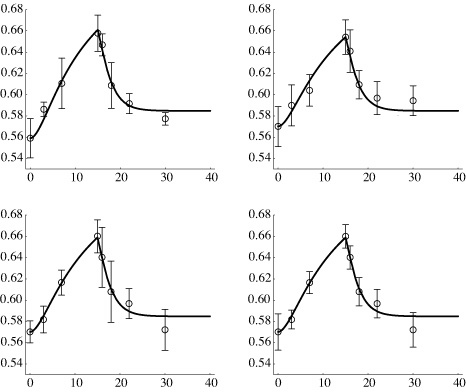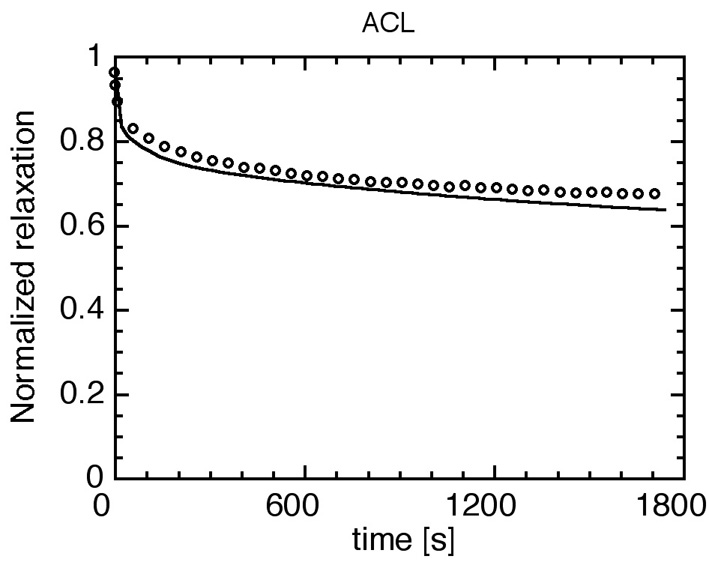Tissue biomechanics
Summary
Living bone has the
ability to adapt its properties to the change of mechanical load
environment. An augmentation of physical activities such as running
significantly increases the bone formation and mineralization whereas a
long-term disuse of the skeleton involves inhibition of bone formation
and induces significant demineralization
of bone.
 Intracortical bone remodeling :
Density evolution during training and detraining
Intracortical bone remodeling :
Density evolution during training and detraining
(Experimental and theoretical results: A, P, L, M), After Terrier, 1999.
In everyday activities, viscosity
of
soft tissues as ligaments, tendons, and arteries, is observed. Stress
depends on strain rate, and on the history of deformations. The
influence of strain history
is one of the main caracteristics of
biological tissues.
 Typical relaxation function of human
ACL, PCL, tendons.
Typical relaxation function of human
ACL, PCL, tendons.
(After Pioletti and Rakotomanana, 1998-2000)
Hard tissue and soft tissue biomechanics are
investigated by means of continuum models undergoing non linear
strains.
- For bone, the
Helmholtz free energy basically depends on the microstructure variables
: apparent density, set of anisotropy tensors, and the strain
tensor. The bone tissue adaptation is described by the evolution law of
apparent density. Bone evolution depends on stress and stress history.
- For soft tissue as ligaments
and tendons, three
contributions are present in constitutive laws: non linear elasticity,
strain dependence and memory effects. Independence of strain and time
effects allows to define the soft tissues constitutive laws by a
Helmholtz free energy, depending on strain tyensor and possibly
depending on a set of anisotropy tensors, by a potential dissipation,
and a set of time relaxation functions (Prony series).
Selected references
Terrier A, Miyagaki J, Fujie H,
Hayashi K, Rakotomanana L. Delay of intracortical bone remodelling
following a stress change : A theoretical and experimental study.
Clinical Biomechanics, Vol 20
pp 998-1006, 2005.
Fujie H, Miyagaki J, Terrier A, Rakotomanana L, Leyvraz PF, Hayashi K.
Detraining effects on the mechanical properties and morphology of rat
tibiae. Biomed Mater Eng
14(2), pp 219-33, 2004.
Pioletti DP, Rakotomanana LR. Can the increase of bone mineral
density
following bisphosphonates treatments be explained by biomechanical
considerations? Clinical Biomechanics,
Vol 19/2 pp 170-174, 2004.
Taylor WR, Roland E, Ploeg H, Hertig D, Klabunde R, Warner MD,
Hobatho
MC, Rakotomanana L, Clift SE. Determination of orthotropic bone
materials properties using FEA and modal analysis, Journal of Biomechanics, 35/6, pp
767-773, 2002.
Pioletti DP, Rakotomanana LR. Non linear viscoelastic laws for
soft
biological tissues, European Journal
Mechanics A/solids 19, pp 749-759, 2000.
Rakotomanana LR, Terrier A, Ramaniraka NA, Leyvraz PF. Anchorage
of
orthopaedic prostheses: influence of bone properties and bone-implant
mechanics, in Synthesis in Bio Solid Mechanics, ed. by P. Pedersen and
M P. Bendsøe, Solid mechanics
and its applications, Vol. 69, Kluwer Academic Publishers,
Dordrecht, 1999, pp 55-66.
Terrier A, Rakotomanana L, Ramaniraka N, Leyvraz PF. Adaptation
models
of anisotropic bone, Computer
Methods in Biomechanics and Biomedical Engineering vol. 1, pp
47-59, 1997.


